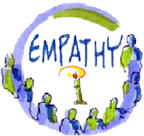|
|
How To Host an Empathy Circle
practicing an empathic way of being
EmpathyCircle.com: A website about Empathy Circles. What is an Empathy Circle?
An Empathy Circle is a method for practicing and experiencing empathy in a small group setting. A Circle is a sort of empathy building 'platform' on which various activities and processes can be added. For example, Empathy Circles have been used to host book club discussions, conflict management discussions, for personal support and discussions centered around social tragedies, such as school shootings. Regardless of the event that occasioned the Circle, the goal is for all present to practice empathizing, to the best of their ability, with themselves and with their fellow circle members. This entails being present with one another in a non-judgmental, authentic, open, and receptive way.
An Empathy Circle process is one of the most accessible and effective ways to practice empathy and, thus, to exercise and grow our empathy muscles. Physical muscles need to have ongoing and regular exercise to keep them toned and fit. The same is true with our empathy muscle system. It needs regular practice, practice, practice, and exercise to be kept in shape and be brought into peak fitness. Just like reading a book about exercise is not enough to keep our bodies fit, reading a book or article about empathy is not enough to strengthen the practice. We need real exercise; we need to stretch, flex, move, and work those muscles. When we have strengthened our empathy muscle system through participation in Empathy Circles, we can move on to more nuanced and sophisticated exercises and grow our capacities even further.
Music also offers a useful metaphor. Participating
in an Empathy Circle is like practicing musical scales when one
begins learning to play an instrument. The Circle provides the basic
scales of empathy that we can practice with others. Eventually, we can
play beautiful music or even a symphony together.
How to Take Part in a Basic Empathy Circle? These are the basic instructions for holding an empathy circle.
How to Take Part in a Basic Empathy Circle (9 Min) (Video)
How to Take Part in a Basic Empathy Circle (25 Min) (Video)
Group Size. The group should have 2 to 6 participants (4 is ideal). If there are more people, divide the larger group into smaller groups of no more than 6 in a circle. The small group size is so participants have a lot of time to speak and actively listen.
Roles: Speaker, Active Listener, or Silent Listener
Participants take the roles of Speaker, Active Listener, or Silent Listener at different times during the Circle.
The process begins with the first Speaker. This Speaker selects the person to whom who they will speak (the Active Listener), and then speaks about whatever comes up for them.
The Active Listener reflects back what they are hearing until the Speaker feels heard to their satisfaction. Then it is the Active Listener's turn to become the Speaker and to select to whom they will speak.
That new Active Listener will then reflect back what they are hearing, using the same process. Dialogue continues in this back and forth fashion for the time allotted.
Meanwhile, those in the group who are not in Speaker or Active Listener roles at any given moment (who we call Silent Listeners) are also paying close attention to the interaction.
Detailed Instructions by Role
Speaker
Active Listener
Silent Listeners
What Have Participants
Said About Empathy Circles? In the empathy circle. I liked...
See More Benefits and Feedback
What Else Can I Do To Nurture an Empathic Way of Being?
Try the Empathy Circle process with your families, friends, community, work colleagues, and more. Once you are comfortable with this basic process, you can start adding more layers on the Empathy Circles by using other empathy community building activities, such as:
"An empathic way of being can be learned from empathic persons. Perhaps
the most important statement of all is that the ability to be accurately
empathic is something which can be developed by training." ― Carl Rogers
What Other Resources about Empathy Circles are Available?
|
|
|
||||







